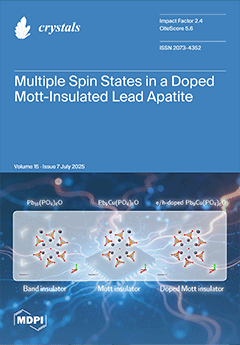Four novel crystalline architectures based on benzo[
c]cinnolininium trifluoromethanesulonate salts, [C
12H
9N
2]
+[CF
3SO
3]
−, have been isolated as single-crystals, and their structures have been determined by X-ray diffraction analysis. The formation
[...] Read more.
Four novel crystalline architectures based on benzo[
c]cinnolininium trifluoromethanesulonate salts, [C
12H
9N
2]
+[CF
3SO
3]
−, have been isolated as single-crystals, and their structures have been determined by X-ray diffraction analysis. The formation of the new salts results from reactions involving the dimeric hydroxo di-
n-butylstannane trifluoromethanesulfonato complex [
n-Bu
2Sn(OH)(H
2O)(CF
3SO
3)]
2 (
1) and benzo[
c]cinnoline (C
12H
8N
2, BCC). Organic salts
I,
II,
III, and
IV were crystallized through slow evaporation at room temperature from a mixture of toluene/dichloromethane. The cystallographic structures of
I,
II, and
IV exhibit the presence of monoprotonated benzo[
c]cinnolinium cations in interactions with a free benzo[
c]cinnoline molecule through N–H···N hydrogen bonding, while for salt
III, the monoprotonated cation directly interacts with the CF
3SO
3− anion via an N–H···O interaction. For all four salts, aromatic
π-
π interactions involving rings of various components (free benzo[
c]cinnoline molecule, benzo[
c]cinnolinium cation, toluene molecule), combined with weak C–H···O and C–H···F interactions implying the trifluoromethanesulfonate anion, promote the solid-state self-assembly of supramolecular stacks. In parallel to the formation of benzo[
c]cinnolinium based-salts, organotin(IV)
1 was converted into a distannoxane compound,
2∞{[
n-Bu
2(
μ-OH)SnOSn(
μ-
η2-O
3SCF
3)
n-Bu
2]
2[
n-Bu
2(
η1-O
3SCF
3)SnOSn(
μ-OH)
n-Bu
2]
2} (
3), which was also isolated as a single crystal and whose crystallographic structure was previously established by us.
Full article





